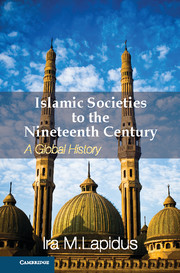Book contents
- Frontmatter
- Contents
- List of Illustrations
- List of Figures
- List of Maps
- List of Tables
- Preface
- Acknowledgments
- Acknowledgments to the first edition of A History of Islamic Societies
- Acknowledgments to the second edition of A History of Islamic Societies
- Publisher's Preface
- Introduction to Islamic Societies
- Part I The Beginnings of Islamic Civilizations
- Part II From Islamic Community to Islamic Society
- Part III The Global Expansion of Islam from the Seventh to the Nineteenth Centuries
- Chapter 25 Introduction: Islamic Institutions
- The Western Islamic Societies
- Islam in Asia
- Islam in Africa
- Chapter 39 The African Context: Islam, Slavery, and Colonialism
- Chapter 40 Islam in Sudanic, Savannah, and Forest West Africa
- Chapter 41 The West African Jihads
- Chapter 42 Islam in East Africa and the European Colonial Empires
- Conclusion
- Glossary
- Bibliography
- Annotated Bibliography from A History of Islamic Societies, 2nd Edition
- Index
Chapter 42 - Islam in East Africa and the European Colonial Empires
Published online by Cambridge University Press: 05 February 2013
- Frontmatter
- Contents
- List of Illustrations
- List of Figures
- List of Maps
- List of Tables
- Preface
- Acknowledgments
- Acknowledgments to the first edition of A History of Islamic Societies
- Acknowledgments to the second edition of A History of Islamic Societies
- Publisher's Preface
- Introduction to Islamic Societies
- Part I The Beginnings of Islamic Civilizations
- Part II From Islamic Community to Islamic Society
- Part III The Global Expansion of Islam from the Seventh to the Nineteenth Centuries
- Chapter 25 Introduction: Islamic Institutions
- The Western Islamic Societies
- Islam in Asia
- Islam in Africa
- Chapter 39 The African Context: Islam, Slavery, and Colonialism
- Chapter 40 Islam in Sudanic, Savannah, and Forest West Africa
- Chapter 41 The West African Jihads
- Chapter 42 Islam in East Africa and the European Colonial Empires
- Conclusion
- Glossary
- Bibliography
- Annotated Bibliography from A History of Islamic Societies, 2nd Edition
- Index
Summary
East Africa, including the eastern Sudan, the East African coasts, and the hinterlands of Ethiopia, Somalia, and Kenya, formed another major zone of Muslim population. Here the sources of Islamic influences were primarily Egypt, Arabia, and the Indian Ocean region, rather than North Africa. (See Map 25.)
Sudan
The history of the eastern Sudan (the modern state of Sudan) was separate from that of the central and western Sudan, due to the fact that Islam reached the eastern Sudan from Egypt rather than from North Africa. Over centuries Arab-Muslims moved deeper and deeper into Sudan. The Arab-Muslim conquerors occupied Egypt as far as Aswan in 641. In the ninth century, Egyptians swarmed to the newly discovered Allaqi goldfields between the Nile and the Red Sea. An early pact, renewed in 975, between Egypt and the king of Maqurra, the northern provinces of the Sudan, provided for a tribute of slaves in exchange for wheat and wine for the Christian Eucharist and for free passage of merchants. In the twelfth and thirteenth centuries Arab bedouins migrated south and married into local families, who adopted Arabic and were drawn into the Islamic cultural orbit. Through matrilineal succession, their children inherited local chieftainships. Arab penetration was followed by the Mamluk conquest of Nubia in 1276, the first of a number of campaigns lasting through the fourteenth century. In 1317 the church of Dongola was rededicated as a mosque. Most of the country, however, was in the hands of local Arab tribal chiefs who continued to push south across northern Kordofan and Darfur and into the Chad basin. In 1517 the Ottoman sultan, Selim I, occupied Nubia as far as the third cataract of the Nile. Nubia remained under Ottoman rule for some 300 years.
- Type
- Chapter
- Information
- Islamic Societies to the Nineteenth CenturyA Global History, pp. 619 - 634Publisher: Cambridge University PressPrint publication year: 2012



